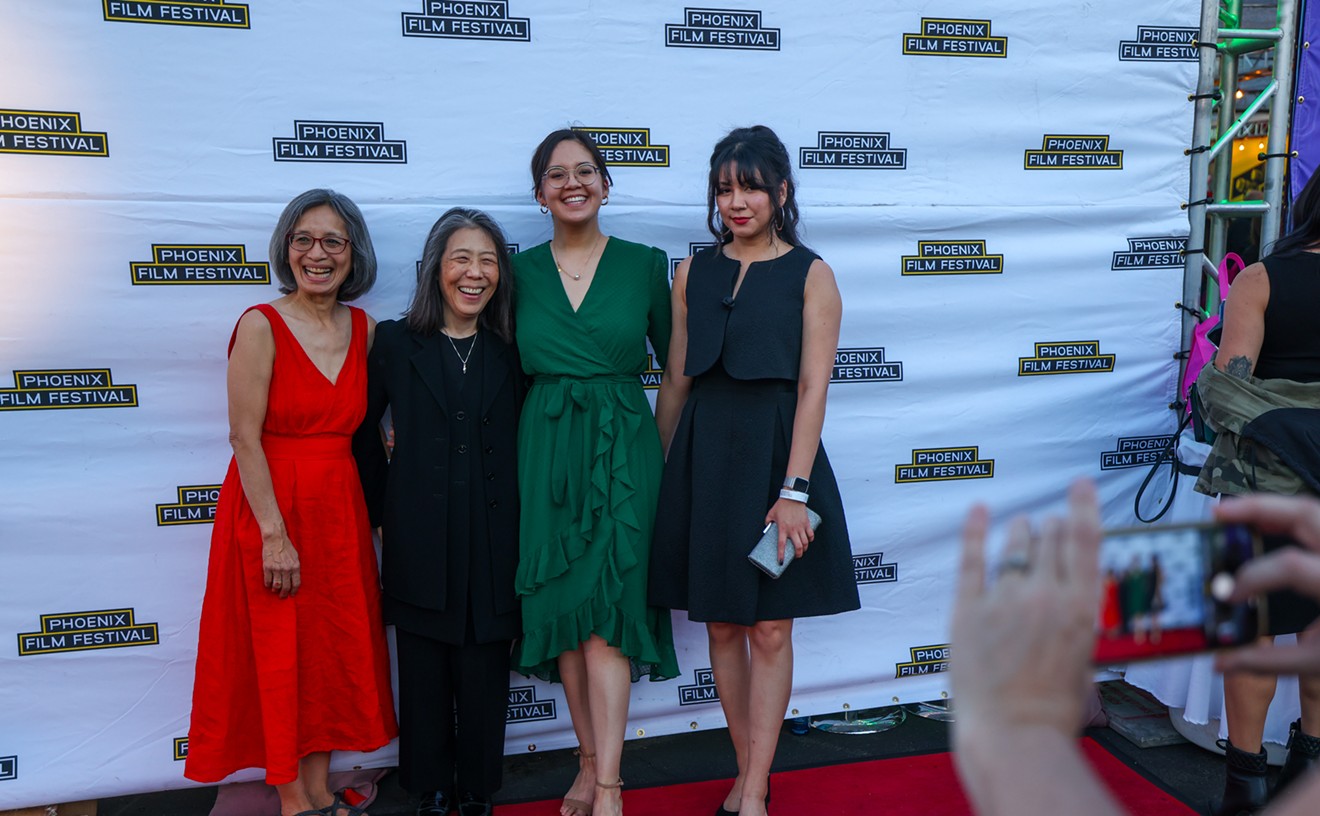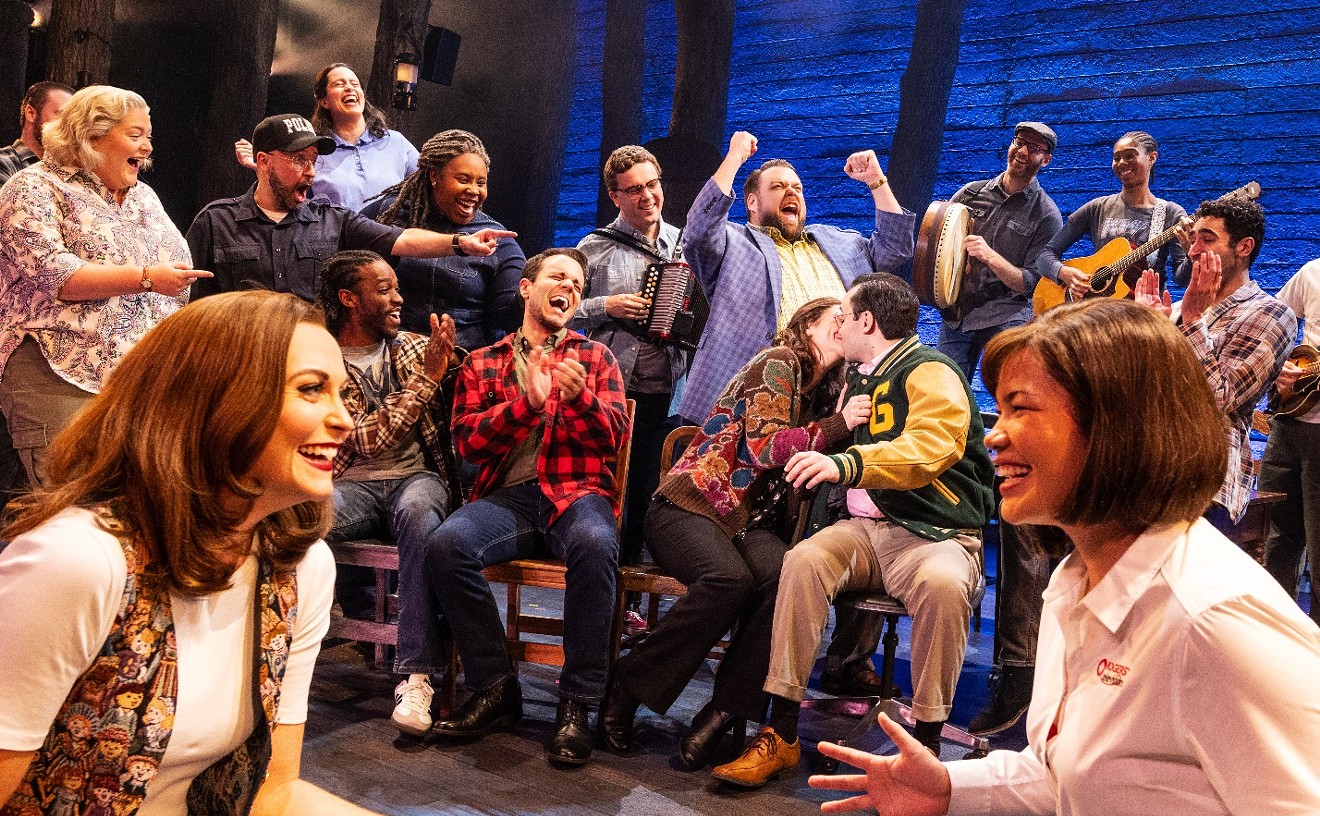If you were in downtown Phoenix before First Friday on November 2, you might have noticed a missing mural. Under the white paint on the west-facing wall of Dougherty Wholesale Floral Co., on Second and Roosevelt streets, was work by painter Carrie Marill that was defaced on November 1. The entire wall was quickly painted over in plain white by Marill and members of Roosevelt Row the next morning.
Marill painted the brick wall in March. The black-and-white mural of a man in a striped shirt on a bike is what Marill describes as an homage to iconic street artist Margaret Kilgallen, who died in 2001.
That night was the second time Marill's mural had been defaced. The first time, Marill says, someone wrote "pirate bootleg rip" over the mural, a likely reaction to her work being inspired by another artist. And though the reaction was nothing new — artists have debated inspiration, appropriation, and the life of ephemeral public art since the emergence of fine art — the defacement raises questions within a community about the value of art and how much that community values the work on its walls.
Cindy Dach is one of Roosevelt Row's founding members. She's also a co-owner of downtown's Eye Lounge Gallery and MADE Art Boutique and a co-owner of Tempe's Changing Hands Bookstore. She was one of the principal organizers of a volunteer day held on Roosevelt Row this past spring that saw 600 volunteers clean up sidewalks and empty lots throughout the neighborhood and help three artists who volunteered to paint murals: Laura Spalding Best, Tara Logsdon — and Carrie Marill.
Dach says she was heartbroken when she saw Marill's mural defaced.
"We're now considering having statements explaining every piece of art, which takes everything to a new level," said Dach after a Roosevelt Row meeting November 2. "It's a sad day for the arts community when artists are attacking artists and we have to think about preservation, about statements on where ideas come from, and when our our art community needs bylines. But people are choosing to respond in a hateful way instead of having a conversation."
Marill says the intent of her mural was simple.
"I was very much inspired by Margaret Kilgallen. [At the time,] I included a statement on the bicycle wheel of the mural that the mural was inspired by her work," she says. She also notes that she wanted to honor Kilgallen, whose piece in the parking garage of the L.A. Contemporary Museum of Art was recently destroyed when the garage was torn down.
"But without that information out there, I think my intention has been misunderstood."
The discussion of protecting public work while encouraging creative discussion is an old one in arts programs across the country. In Phoenix, murals have been painted on private and public walls for decades. And as their popularity has grown, so has the effort to keep them intact and safe from vandalism.
With the help of historians, professional art restorers, and volunteer artists, public art programs in Philadelphia, New York, and Los Angeles are continuing to preserve public work created by artists for more than 50 years. This month, an ordinance passed in Los Angeles to lift a long-standing ban on murals on private property.
But that process is complicated when reactions to art on the street are often spelled out in spray paint and the lines between art, graffiti, and public speech blur.
Along Roosevelt Row and 16th Street, the mural movement is in full swing. Artists including El Mac, Thomas "Breeze" Marcus, Sentrock, Antigirl, Andy Brown, J.B. Snyder, DOSE, Lalo Cota, Gennaro Garcia, Hugo Medina, and Colton Brock (to name a few) have transformed walls throughout the city with artwork, which has inspired a running series called "Mural City" on Jackalope Ranch, New Times' culture blog (phxculture.com). These artists know the nature of painting on the streets — their work often is ephemeral, up for public commentary, and subject to tagging and destruction, which is notably prohibited under Arizona law.
But the law can do little to protect murals before they are defaced, and as a result, these murals are no strangers to tagging.
On the morning of November 2, it was clear that Marill's mural had been a target. Red paint covered her entire design in sloppy, thick blocks that outlined her character. New Times has agreed not to run photos of Marill's defaced mural (or details of the tagging and defacement of murals mentioned above), as the goal of anyone who tags over a work of art is destruction and attention.
"These artists painted for free," says Dach. "And this kind of reaction is a slap in the face to the artists and to the volunteers . . . When people say negative things about Phoenix, these actions only reinforce those things."
While art fans and community members wandered through exhibitions during First Friday, Marill and a few volunteers set up scaffolds and repainted her original design. She says she hopes the more obvious inscription — "A loving homage to the great Margaret Kilgallen" written on several boxes in cyclist's boxes — will better explain her design.
"I know it's not the end of the world," she says, "but if I could just talk to the person who did it, I feel like there would be a much better understanding."










